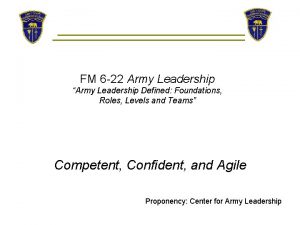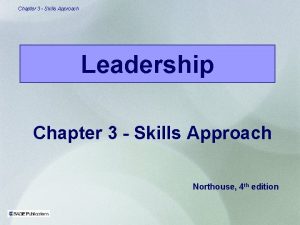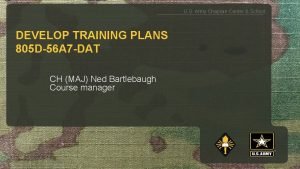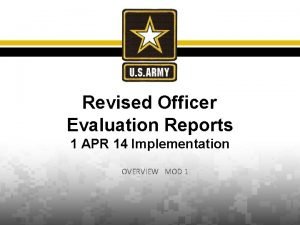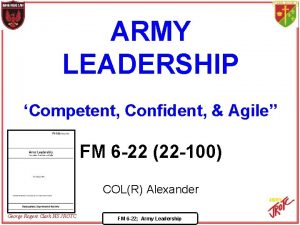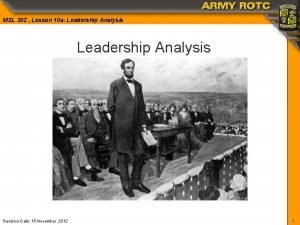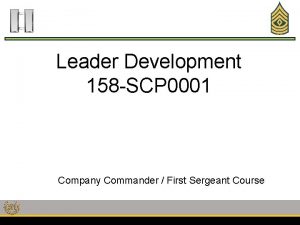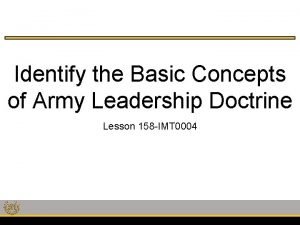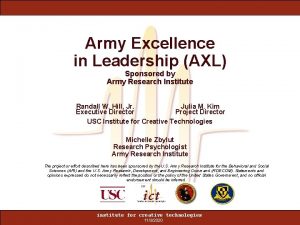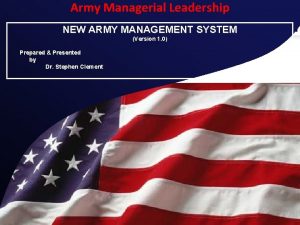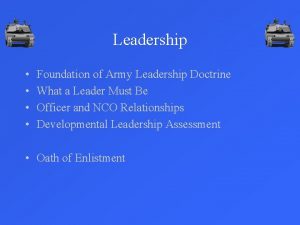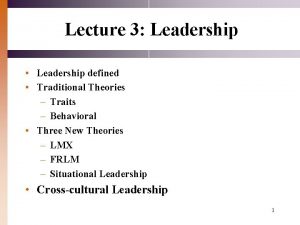FM 6 22 Army Leadership Army Leadership Defined

















- Slides: 17

FM 6 -22 Army Leadership “Army Leadership Defined: Foundations, Roles, Levels and Teams” Competent, Confident, and Agile Proponency: Center for Army Leadership

The Agile Multi-skilled Leader

Course Outline 1. Leadership definition 2. Leader definition 3. Roles of cadet leaders 4. The cadet Leadership Requirements Model 5. Levels of Leadership 6. Leader Teams 7. Serving as a Responsible Subordinate 8. COL Chamberlain vignette

Leadership Defined Cadet leadership is defined as influencing people by providing purpose, direction, and motivation while operating to accomplish the mission and improving the organization. Influencing (Lead) Accomplishing (Achieve) Improving (Develop)

Leader Defined A Cadet leader is anyone who by virtue of assumed role or assigned responsibility inspires and influences people to accomplish organizational goals. Army leaders motivate people both inside and outside the chain of command to pursue actions, focus thinking, and shape decisions for the greater good of the organization.

Roles & Relationships • • • Officers/warrant officers Non-commissioned officers Army Civilian Corps Joint/multinational Defense contractors

Officers and Warrant Officers

Non-Commissioned Officers

Army Leadership Requirements Model BE KNOW DO

Teams and Task Forces • Teambuilding • Leader teams

Leader Teams • Leader teams ØHorizontal teams ØVertical teams • Shared leadership

Serving as a Responsible Subordinate • • • Team player Understand the leader’s vision Share responsibility Pride in accomplishment Loyal to leader

Colonel Chamberlain at Gettysburg • COL Joshua Chamberlain • 20 th Maine Regiment (Pennsylvania) • Little Round Top • Innovative thinking • Confusion of battle Read vignette

Chamberlain • What values did he exhibit? • Which core leader competencies did he display? • What level of leadership was Chamberlain operating at? • What types of leader teams did he have to deal with? • What type of an example did he set for those around him?

Teambuilding Back to Teams

COL Chamberlain vignette Colonel Chamberlain at Gettysburg In late June 1863 General Robert E. Lee’s Army of Northern Virginia passed through western Maryland invaded Pennsylvania. For five days, the Army of the Potomac hurried to get between the Confederates and the national capital. On 1 July 1863, the 20 th Maine received word to press on to Gettysburg. The Union Army had engaged the Confederates there, and Union commanders were hurrying all available forces to the hills south of the little town. The 20 th Maine arrived at Gettysburg near midday on 2 July, after marching more than one hundred miles in five days. They had only two hours sleep and no hot food during the previous 24 hours. The regiment was preparing to go into a defensive position as part of the brigade commanded by COL Strong Vincent when a staff officer rode up to COL Vincent and began gesturing towards a little hill at the extreme southern end of the Union line. The hill, Little Round Top, dominated the Union position and, at that moment, was unoccupied. If the Confederates placed artillery on it, they could force the entire Union Army to withdraw. The hill had been left unprotected through a series of mistakes—wrong assumptions, the failure to communicate clearly, and the failure to check. The situation was critical. Realizing the danger, COL Vincent ordered his brigade to occupy Little Round Top. He positioned the 20 th Maine, commanded by COL Joshua L. Chamberlain, on his brigade’s left flank, the extreme left of the Union line. COL Vincent told COL Chamberlain to “hold at all hazards. ” On Little Round Top, COL Chamberlain issued his intent and purpose for the mission to the assembled company commanders. He ordered the right flank company to tie in with the 83 d Pennsylvania and the left flank company to anchor on a large boulder because the 20 th Maine was literally at the end of the line. COL Chamberlain then showed a skill common to good tactical leaders. He mentally rehearsed possible countermoves against imagined threats to his unit’s flank. Since he considered his left flank highly vulnerable, COL Chamberlain sent B Company, commanded by CPT Walter G. Morrill to guard it and “act as the necessities of battle required. ” The captain positioned his men behind a stone wall, facing the flank of any possible Confederate advance. Fourteen Soldiers from the 2 d U. S. Sharpshooters, previously separated from their own unit, joined them. The 20 th Maine had only been in position a few minutes when the Soldiers of the 15 th and 47 th Alabama attacked. The Confederates, having marched all night, were tired and thirsty, but they attacked ferociously. The Maine men held their ground until one of COL Chamberlain’s officers reported seeing a large body of Confederate Soldiers moving laterally behind the attacking force. COL Chamberlain climbed on a rock and identified a Confederate unit moving around his exposed left flank. He knew that if they outflanked him, his unit would be pushed off its position, facing sure destruction. Return to lesson

COL Chamberlain vignette (cont) COL Chamberlain had to think fast. The tactical manuals he had so diligently studied only offered maneuver solutions, unsuitable for the terrain he occupied. The colonel had to create a new maneuver solution—one that his Soldiers could execute now and under pressure. Since the 20 th Maine was in a defensive line, two ranks deep, and it was threatened by an attack around its left flank, the colonel ordered his company commanders to stretch the line to the left. While keeping up a steady rate of fire, his line ultimately connected with the large boulder he had pointed out earlier. The sidestep maneuver was tricky, but it was a combination of other battle drills his Soldiers knew. In spite of the terrible noise that made voice commands difficult, blinding smoke, the cries of the wounded, and the continuing Confederate attack—the Maine men succeeded. Although COL Chamberlain’s thin line was only one rank deep, it now covered twice their normal frontage and was able to throw back the Confederate infantry, assaulting a flank they thought was unprotected. Despite desperate confederate attempts to break through, the Maine men rallied and held again and again. After five desperate encounters, the Maine men were down to one or two rounds per man, and the determined Confederates were regrouping for another try. COL Chamberlain recognized that he could not stay where he was—but that he could not withdraw, either. He decided to attack. His men would have the advantage of attacking down the steep hill, he reasoned, and the Confederates would not be expecting it. Clearly he was risking his entire unit, but the fate of the Union Army depended on his men. The decision left COL Chamberlain with another problem: there was nothing in the tactics book about how to get his unit from current disposition into a firm line of advance. Under tremendous fire and in the midst of the battle, COL Chamberlain assembled his commanders. He explained that the regiment’s left wing would swing around “like a barn door on a hinge” until it was even with the right wing. Then the entire regiment, bayonets fixed, would charge downhill, staying anchored to the 83 d Pennsylvania on the right. The explanation was as simple, as the situation was desperate. When COL Chamberlain gave the order, 1 LT Holman Melcher of F Company leaped forward and led the left wing downhill toward the surprised Confederates. COL Chamberlain had positioned himself at the boulder at the center of the unfolding attack. When his unit’s left wing came abreast of the right wing, he jumped off the rock and led the right wing down the hill. The entire regiment was now charging on line, swinging like a great barn door—just as he had intended. The Alabama Soldiers, stunned at the sight of the charging Union troops, fell back on the positions behind them. There, the 20 th Maine’s charge might have failed. Just then, CPT Morrill’s B Company and the sharpshooters opened fire on the Confederate flank and rear, just as envisioned by COL Chamberlain. The exhausted and shattered Alabama regiments now thought they were surrounded. They broke and ran, not realizing that one more attack would have carried the hill for them. At the end of the battle, the slopes of Little Round Top were littered with bodies. Saplings halfway up the hill had been sawed in half by weapons fire. A third of the 20 th Maine had fallen— 130 men out of 386. Nonetheless, the farmers, woodsmen, and fishermen from Maine—under the command of a brave and creative leader, who had anticipated enemy actions, improvised under fire, and applied disciplined initiative in the heat of battle—had fought through to victory. Return to lesson
 Fm 6-22
Fm 6-22 A collection of well-defined objects.
A collection of well-defined objects. Leadership skills are defined in the chapter as
Leadership skills are defined in the chapter as Combined arms registry
Combined arms registry Army oer support form example
Army oer support form example Leadership attributes army
Leadership attributes army Army leadership requirements model
Army leadership requirements model Army servant leadership vs followership venn diagram
Army servant leadership vs followership venn diagram Scp0001
Scp0001 Leadership requirements model army
Leadership requirements model army Enthusiastic beginner disillusioned learner
Enthusiastic beginner disillusioned learner Transformational vs transformative leadership
Transformational vs transformative leadership Adaptive leadership characteristics
Adaptive leadership characteristics Dedicated defined benefit services
Dedicated defined benefit services Define:recursively
Define:recursively Wilhelm wundt school of psychology
Wilhelm wundt school of psychology Strategic management is an art or science
Strategic management is an art or science Hdsdr setup
Hdsdr setup
